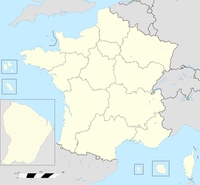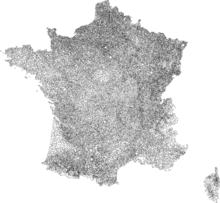Territorial organization of France
The territorial organization of France, which divides the national territory into hierarchical administrative subdivisions, is based on a balance between local authorities, administered by elected councils and endowed with genuine management autonomy, and the non-elected decentralized state services, in charge of guaranteeing the unity of the Republic and the principle of equality before the law.
There are three levels of territorial authorities, communes, departments and regions, known as common law territorial authorities. Communities with special status, overseas communities and New Caledonia complete the system. A fourth intermediate level between the commune and the department is made up of inter-municipal cooperation structures (public inter-municipal cooperation establishments with their own tax regime or unions), which They are not territorial authorities, but whose deliberative assemblies are made up of elected representatives of the member municipalities: the cantons and the districts. The number of these structures and the overlapping of powers between them, which evolve as a function of the reforms, have given rise to the expression millefeuille territorial (in Spanish: territorial milhojas), which different governments have tried make it simpler, more legible and more efficient for citizens.
Territorial communities
Ordinary communities
Regions
Inheritors in part of the former provinces and historical regions, the administrative regions were created in their pre-2016 form from 1960 and acquired the status of territorial collectivity in 1982, enshrined in the Constitution since 2003. On January 1 In 2016, the number of administrative regions was reduced from twenty-seven to eighteen (thirteen in metropolitan France and five overseas), following the law of January 16, 2015.
Within the same territory, there is a territorial authority with an elected council, the regional council, and an administrative district with a regional prefect. While the total number of regions, as administrative divisions of the State, is 18, the number of regions as common law territorial entities is only 14 (12 in metropolitan France and two overseas: Guadeloupe and Reunion). There are also four special status authorities at the regional level (Corsica in metropolitan France and Mayotte, French Guiana and Martinique in the overseas territories). It should also be noted that some metropolitan regions have specific characteristics, such as the Île-de-France: the particularities of this region are due to its size and the number of its inhabitants, but also to its powers, which are broader than those of the other regions. The five overseas regions have the status of outermost regions of the European Union.
As communities, the regions have two assemblies, unlike other communities that only have one: a deliberative assembly, the regional council, and a consultative assembly, the regional economic, social and environmental council, which represents the "living forces " region of. The president of the regional council is the executive of the community.
Departments
The creation of the French departments dates back to the decree of December 22, 1789 issued by the Constituent Assembly of 1789, which entered into force on March 4, 1790. Their limits are inspired by older projects of reorganization of the territory, drawn up under royalty by Marc-René d'Argenson as early as 1665 and enshrined in an edict in 1787, or by Condorcet in 1788.
Within the same territory, there is a territorial authority with an elected council, the departmental council, and an administrative district with a departmental prefect. While the total number of departments as administrative divisions of the State is 101, the number of departments as common law territorial authorities is only 93 (91 in metropolitan France and two overseas: Guadeloupe and Reunion). Seven special status authorities complete the departmental level, but are not departments in the legal sense of the term: Mayotte since 2011, Martinique, French Guiana and the Lyon metropolis since 2015, Corsica since 2018, Paris since 2019 and the European collectivity of Alsace. since 2021.
As regards Guadeloupe and La Réunion, there is no true analogy between the overseas departments and the metropolitan departments: although article 73 of the Constitution establishes that in the overseas departments and regions the laws and regulations are applicable by operation of law, it also indicates that these texts may foresee adaptations to take into account the specific characteristics of these territories. Above all, section 2 of article 73 establishes that overseas departments and regions may be authorized to establish the rules applicable in their territory. Thus, these categories of authorities can be given broad regulatory powers through laws and regulations.
The organization of the decentralized services of the civil administrations of the State within the framework of departmental and district circumscriptions is not modified by the decree creating the new collectivity. As of January 1, 2021, the The number of departmental authorities is reduced to 94, including 92 in metropolitan France, while the number of departmental districts remains at 101.
Communes
Created in 1789 to replace parishes, municipalities are the basic level of the administrative divisions of French territory. The municipalities are governed by Title XII of the 1958 Constitution and the second part of the General Code of Territorial Communities. However, although they constitute a uniform legal category, French communes are characterized by great heterogeneity, both as regards the size of their territory and the number of their population. To remedy the fragmentation of the municipalities, various measures have attempted to reduce the number of municipalities, such as the Marcelino Law of July 16, 2011. Given the failure of this law, other measures were put in place, in particular the possibility of creating new municipalities in application of the law no. 2010-1563, of December 16, 2010, on the reform of territorial communities, reinforced by the law of March 16, 2015 on the improvement of the regime of the new municipality for strong municipalities and thriving. These measures made it possible to reduce the number of municipalities below the symbolic mark of 36,000 in 2016 and then, in 2019, below the mark of 35,000.
A municipality is administered by a municipal council elected for six years and chaired by a mayor. The mayor also represents the State in the municipality for certain functions. In particular, the mayor is responsible for the publication of laws and regulations, has powers in electoral matters (carrying the electoral census, organizing elections), and has special police powers (advertising, posters, immigration police: visa or certificate of accommodation). He is also an official of the civil registry and of the judicial police. Being also a decentralized authority, the mayor therefore benefits from functional duplication.
Until 2018, Paris was both a municipality and a department: the council of Paris met as a municipal council or as a general council, depending on the powers it exercised. On January 1, 2019, the department and the municipality were merged into a single entity, the City of Paris, with the status of a special status authority.
Overseas Communities
The constitutional revision of 2003 introduced the concept of overseas collectivity and suppressed that of overseas territory, but maintained the departments, although accentuating the peculiarities recognized in this category. Overseas collectivities are made up of Saint Pierre and Miquelon, Wallis and Futuna, French Polynesia and, since 2011, Saint Martin and Saint Barthélemy. In fact, these collectivities are very heterogeneous, as a consequence of article 74 of the Constitution, which establishes that "overseas collectivities governed by this article will have a statute that takes into account the specific interests of each of them within the Republic". The status of each overseas collectivity is defined by an organic law. However, beyond this great heterogeneity, there are common points: the institutions of the community must be consulted on bills and draft ordinances or decrees that include provisions relating to the community. The statute of overseas collectivities was specified by the organic law of February 21, 2007, which determined in particular the system of application of laws and regulations in these territories.
French Polynesia benefits from a strengthened statute of autonomy: it can adopt lois de pays (national laws) in certain fields such as public health, education or labor law. These "laws" are subject to control by the Conseil d'État, which exercises control similar to that exercised by the Conseil constitutionnel over laws. The institutions of this community also have specific characteristics: Polynesia has an assembly that can challenge the responsibility of the Polynesian government through a vote of no confidence.
Sui generis community of New Caledonia
New Caledonia is governed by Title XIII of the Constitution and enjoys particular autonomy: the New Caledonian Assembly (known as the Congress) can adopt lois de pays which, unlike the lois de pays of French Polynesia, are not administrative acts and, therefore, are subject to the control of the Constitutional Council. In addition to Congress, New Caledonia has a collegiate executive called the government and a customary senate that is consulted on projects related to Kanak identity. It has broad powers, even in royal domains, to the point that it does not fall into the category of territorial authorities. It seems to have a status halfway between that of a State and that of a collectivity.
The provinces of New Caledonia (South Province, North Province and Province of the Loyalty Islands) are collectivities with powers in all sectors not attributed by law to the State, New Caledonia and municipalities.
On November 4, 2018, a referendum on access to independence was held under the Nouméa Accord. This was the second referendum on the independence of New Caledonia, after the one held in 1987. The vote -marked by a high turnout (81.01%)- saw 56.67% of voters say "no" to the proposal of independence. The results reiterate the significant disparity between the two main communities, Kanak and European, while 17% of voters living in the archipelago are excluded from voting, according to the lists established by the Nouméa Accord. A second referendum on the territory's independence was held on October 4, 2020, postponed for a month due to the Covid-19 pandemic. Voters again voted 53.26% in favor of "no" to independence. Following this negative response, supporters of "yes" to independence can request a third and definitive referendum, which would take place at the end of 2022 maximum, as provided for in the Nouméa Accord.
Other types of territorial organization
Cantons
The cantons of France are territorial subdivisions of the departments and districts of France, and are the electoral constituency of the departmental councillors, members of the departmental council.
Apart from their role as organizational units in relation to certain aspects of the administration of public services and justice, the main purpose of cantons today is to serve as constituencies for the election of members of representative assemblies established in each of France's territorial departments (departmental councils) formerly general councils. For this reason, such elections were known in France as "cantonal elections", until 2015, when their name was changed to "departmental elections" to match the name of departmental councils.
Arrondissements or districts
The arrodissement or district is the smallest administrative circumscription in France, that is, a geographical area resulting from a division of the national territory for administrative management purposes. It is an intermediate subdivision between the department and the canton, and is quickly assimilated to the subprefecture. Without legal personality, it serves as a framework for State action in this territory and has become, since the cantonal reduction of 2015, a supra-community division.
A district is generally named after its principal city (the sub-prefecture, unless it is the prefecture of the department) and is administered by a sub-prefect (except the district whose principal city is also that of the department, which is administered by the general secretary of the prefecture).
As of March 29, 2017, there are 332 arrondissements in France.
Unlike French regions, departments and communes, arrondissements have no legal entity under public law. Also, unlike those other administrative divisions, they are not run by elected officials, but by political appointees, officials appointed by the French president.
Contenido relacionado
Anastasio Somoza Debayle
Papinian
Frankfurt Parliament





